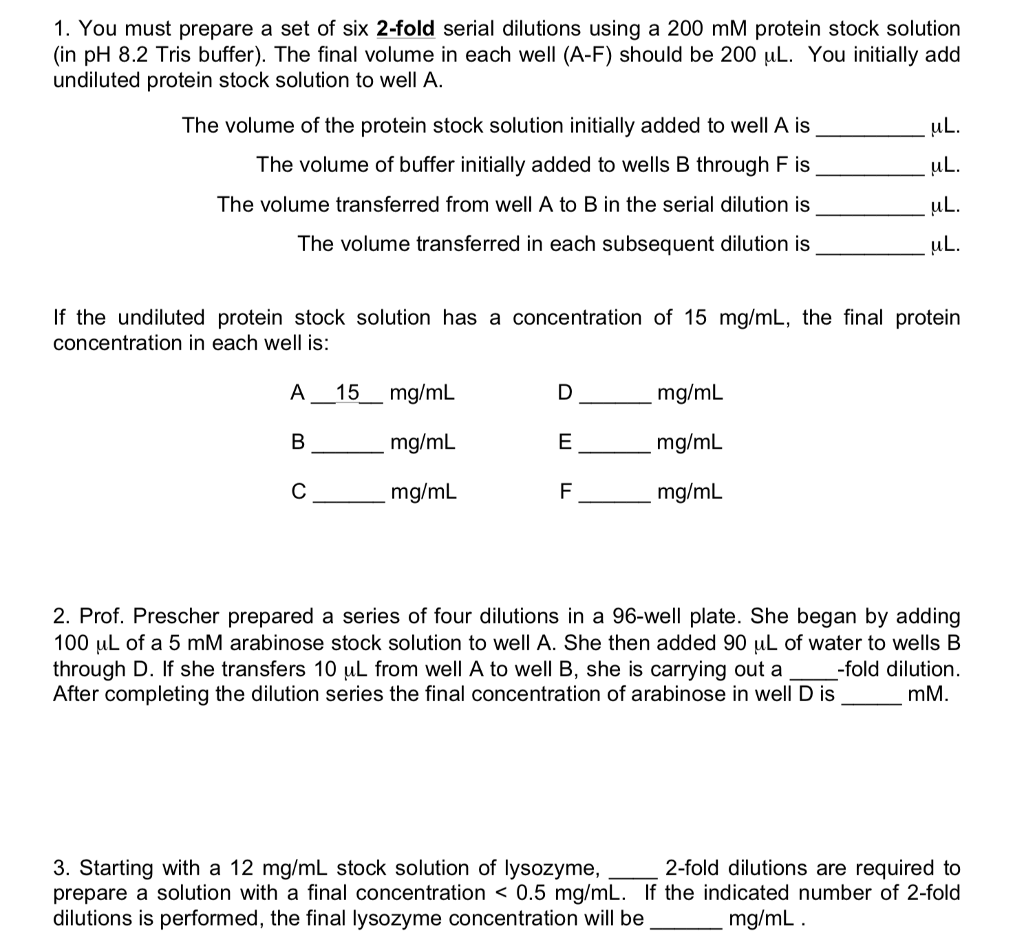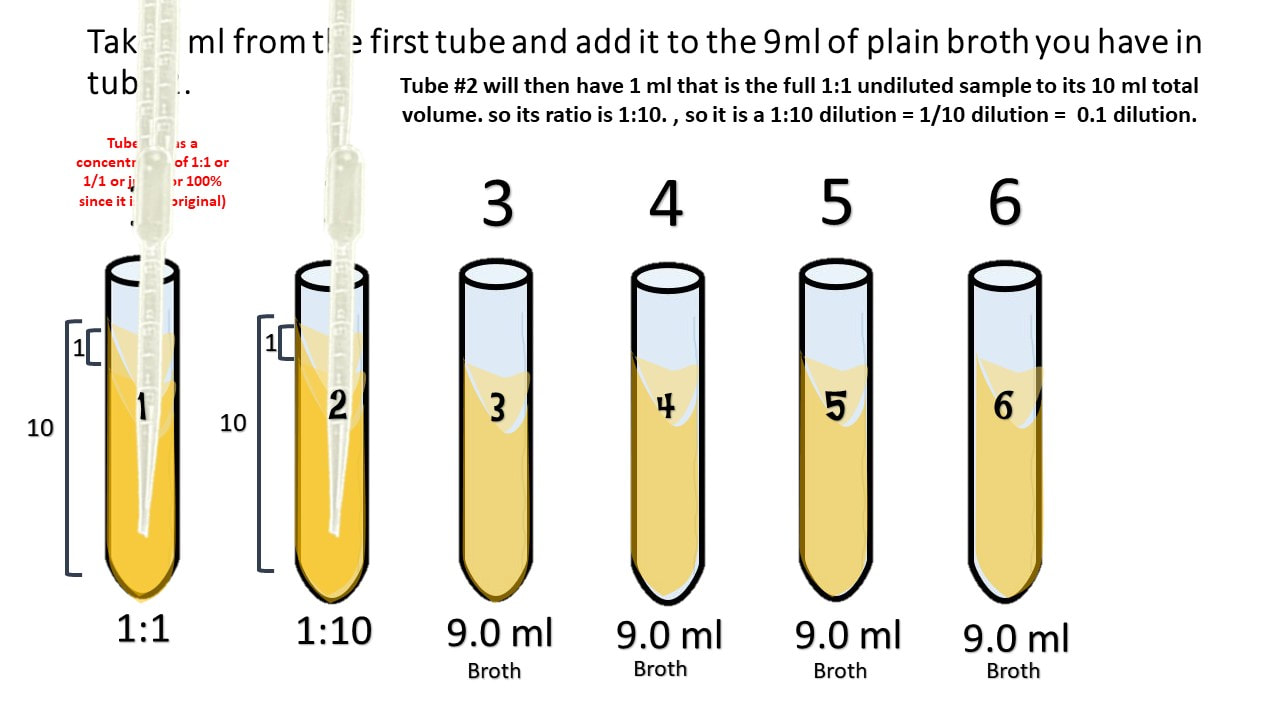3 Fold Serial Dilution
In a two-fold dilution, the volume of the original solution is always doubled, as in going from 1 to 2. A three-fold dilution would be a tripling of the solution volume, as in going from 1 to 3. Although not a serial dilution, the below is an example of a two-fold dilution. If you are wondering how to do serial dilutions, this serial dilution calculator is the tool for you.Here, we provide you with every imaginable piece of information regarding serial dilutions; from calculations for the required volume of solution at the end of each dilution, to the exact amount of stock solution and dilutant needed to make the first solution, to the dilution factor of the.
- 3 Fold Serial Dilution Charts
- 3 Fold Serial Dilution Chart
- 3 Fold Serial Dilution Key
- 3 Fold Serial Dilution Calculator
Serial Dilution
Problem #1: The following successive dilutions are applied to a stock solution that is 5.60 M sucrose:
Solution A = 46.0 mL of the stock solution is diluted to 116 mL
Solution B = 58.0 mL of Solution A is diluted to 248 mL
Solution C = 87.0 mL of Solution B is diluted to 287 mL
What is the concentration of sucrose in solution C?
Solution: (the solution will be followed by some discussion)
1) Assign unknowns to the final molarities of each dilution:
molarity of solution A = x
molarity of solution B = y
molarity of solution C = z
2) Set up all three dilutions using M1V1 = M2V2
Solution A ⇒ (5.60) (46) = (x) (116)
Solution B ⇒ (x) (58.0) = (y) (248)
Solution C ⇒ (y) (87.0) = (z) (287)
3) Each of these three eqations may now be solved in turn to give the final answer (symbolized by the variable z):
Solution A ⇒ (5.60) (46) = (x) (116)x = 2.2207 M
Solution B ⇒ (2.2207) (58.0) = (y) (248)
y = 0.51936 M
Solution C ⇒ (0.51936) (87.0) = (z) (287)
z = 0.157 M (this is the final answer)
Advice: if you use the above technique, make sure to carry several guard digits as you do each calculation. In the above, I carried two guard digits in my values for x and y.
I would like to now reconsider the solution. In place of the specific numbers in step two, I would like to use symbols:
Solution A ⇒ (Ci) (V1) = (x) (V2)Solution B ⇒ (x) (V3) = (y) (V4)
Solution C ⇒ (y) (V5) = (Cf) (V6)
x and y = intermediate concentrations
Ci = initial concentration
Cf = final concentration
I'm now going to form one equation that relates Ci and Cf. To do this, I will eliminate the intemediate concentrations symbolized by x and y. First x:
(C i) (V
i) (V 1) = (x) (V2)
1) = (x) (V2)x = (Ci) (V1 / V2)
Now, substitue into the equation for solution B:
(Ci) (V1 / V2) (V3) = (y) (V4)y = (Ci) (V1 / V2) (V3 / V4)
Now, substitue into the equation for solution C:
(Ci) (V1 / V2) (V3 / V4) (V5) = (Cf) (V6)(Ci) (V1 / V2) (V3 / V4) (V5 / V6) = Cf
Let's see if it works:
Cf = (5.60) (46 / 116) (58 / 248) (87 / 287)Cf = 0.157 M
Hey! It works!
Notice that each volume ratio represents a dilution. Consequently, each volume ratio is a factor less than 1.
Problem #2: What is the molarity of dilution 1?
1) A stock solution of salicylic acid is diluted by transferring 10.0 mL of the stock solution into a beaker and adding 40.0 mL of water. The beaker is labeled dilution 1.2) 5.00 mL of the solution in the beaker labeled dilution 1 is transferred to another beaker and 15.0 mL of water is added. The beaker is labeled dilution 2.
3) 5.00 mL of the solution in the beaker labeled dilution 2 is transferred to another beaker and 15.0 mL of water is added. The beaker is labeled dilution 3.
4) 1.00 mL of the solution in the beaker labeled dilution 3 is transferred over to another beaker called dilution 4 and enough water is added so that the final volume is 5.00 mL and the concentration of the final dilution is 2.10 x 10-6 M.
Solution:
1) from dilution 4 to dilution 3:
(x) (1.00 mL) = (2.10 x 10-6) (5.00 mL)x = 1.05 x 10-5 M (concentration of dilution 3)
2) from dilution 3 to dilution 2:
(x) (5.00 mL) = (1.05 x 10-5 mol/L) (20.0 mL)x = 4.20 x 10-5 M (concentration of dilution 2)
3) from dilution 2 to dilution 1:
(x) (5.00 mL) = (4.20 x 10-5mol/L) (20.0 mL)x = 1.68 x 10-4 M (concentration of dilution 1)
4) from dilution 1 to the stock:
(x) (10.00 mL) = (1.68 x 10-4mol/L) (50.0 mL)x = 8.40 x 10-4 M (concentration of the stock solution)
Note how the problem is worded to avoid giving a final volume. It simply tells you the starting volume (5.00 mL in 2 and 3) and that 15.0 mL was added. Nowhere does it state that the solution was diluted to 20 mL. Also, note the implicit assumtion that the volumes are additive. This is a resonable assumption in this example.
Here is a repeat of the combined equation from above:
(Ci) (V1 / V2) (V3 / V4) (V5 / V6) = Cf
Since there are four dilutions in Problem #2, I will add another volume term:
(Ci) (V1 / V2) (V3 / V4) (V5 / V6) (V7 / V8) = Cf
Since we are interested in Ci, let us move all the volume terms to the other side:
Ci = (Cf) (V2 / V1) (V4 / V3) (V6 / V5) (V8 / V7)
Now, let us insert values into the revised equation (please note that all even subscripts are the final molarity and the odd subscripts are the starting molarity):
Ci = (2.10 x 10-6) (50 / 10) (20 / 5) (20 / 5) (5 / 1) = 8.40 x 10-4 M
Problem #3: You have prepared 10 mL of a stock solution of 1.000 M hydrochloric acid, HCl. You serially dilute the stock solution 3 times, such that each step of the serial dilution dilutes the original solution by 1/2. What will the final concentration be in the final test tube?
Solution #1:
Start with 10 mL of 1 M solution (I'll ignore sig figs for the moment).Take the 10 mL of solution and add 10 mL of water. The solution is now 20 mL of 0.5 M.
Take the 20 mL of solution and add 20 mL of water. It's now 40 mL of 0.25 M.
Take the 40 mL of solution and add 40 mL of water. It is now 80 mL 0.125 M.
So, the final concentration is 0.125 M.
Note how the concentration is cut in half each time the total volume doubles.
Solution #2:
This is a cleaned up version of the answer I copied from Yahoo Answers: Rob papen subboombass 2 1.0.1a crack.
OK, so you're starting with 10 mL of 1 M solution and you're diluting it by half.So take 5 mL of solution and add 5 mL of water, the solution is now 0.5 M.
Take 5 mL of that and add 5 mL of water. It is now 0.25 M
Take 5 mL of that and add 5 mL of water. It is now 0.125 M.
The final concentration is 0.125 M.
Note how only the stock solution is used as well as half of each diluted solution in each step. This is the correct way to do this type of dilution in the lab. If you spill a solution in a given step, you can return to the solution of the previous step and continue (after you clean up the spill!).
I did not use any of the notation used in Problems #1 and #2. I will leave that as an exercise to the reader.
The above type of dilution is called a two-fold dilution. In a two-fold dilution, the volume of the original solution is always doubled, as in going from 1 to 2.
A three-fold dilution would be a tripling of the solution volume, as in going from 1 to 3.
Although not a serial dilution, the below is an example of a two-fold dilution.
Problem #4: To make a two-fold dilution of 10 mL of solution, what amount of solvent would you use and how would you do this?
To perform a dilution you can always use the equation:(Volume of solution)/(vol of solution + vol of solvent)
Since it is a two-fold dilution, you use the same volume of solvent as you have of solution.
In this case, you just add ten milliliters:
(10)/(10 + 10) = 1/2 ---> a 1 to 2 dilution (also called two-fold).
3 Fold Serial Dilution Charts
If this was a three-fold dilution, we would have this: (10)/(10 + 20) = 1/3 ---> a 1 to 3 dilution (also called three-fold).
Problem #5: To prepare a very dilute solution, it is advisable to perform successive dilutions of a single prepared reagent solution, rather than to weigh out a very small mass or to measure a very small volume of stock chemical. A solution was prepared by transferring 0.661 g of K2Cr2O7 to a 250.0-mL volumetric flask and adding water to the mark. A sample of this solution of volume 1.000 mL was transferred to a 500.0-mL volumetric flask and diluted to the mark with water. Then 10.0 mL of the diluted solution was transferred to a 250.0-mL flask and diluted to the mark with water.
(a) What is the final concentration of K2Cr2O7 in solution?
(b) What mass of K2Cr2O7 is in this final solution?
Solution:
1) Calculate the molarity of the first solution thusly:
MV = mass / molar mass(x) (0.2500 L) = 0.661 g / 294.181 g/mol
x = 0.008987664 M (I won't round off very much until the end.)
2) Now, use this for the first dilution (1.000 mL to 500.0 mL):
M13 Fold Serial Dilution Chart
V1 = M2V3 Fold Serial Dilution Key
23 Fold Serial Dilution Calculator
(0.008987664 mol/L) (1.000 mL) = (x) (500.0 mL)
x = 0.000017975328 M
3) Use M1V1 = M2V2 again for the second dilution (10.00 mL to 250.0 mL):
(0.000017975328 mol/L) (10.00 mL) = (x) (250.0 mL)x = 0.00000071901312 M
Rounded to four sig figs, it is 0.0000007190 M (the answer to part (a) of the question)
4) Lastly, use MV = mass / molar mass to get the mass of K2Cr2O7 in the final 250 mL of solution.
(0.00000071901312 mol/L) (0.2500 L) = x / 294.181 g/molx = 0.00005288 g (or, if you prefer 5.288 x 10-5 g)
This answer to part (b) gives the amount that would have had to have been weighed out if the solution had been prepared directly.